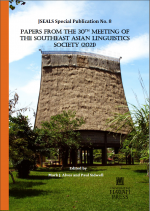Citation:

Abstract:
Porohanon, spoken in the Municipality of Poro, Camotes, Cebu is a member of the Central Bisayan branch of the Bisayan complex (Zorc 1977). Previous descriptions of this speech variety (Wolff 1967, Zorc 1977, Ballo 2011) have tended to classify its common noun markers into NOMINATIVE, GENITIVE, and OBLIQUE case forms. These forms are also purported to encode distinctions of DEFINITE versus INDEFINITE and SPECIFIC versus NONSPECIFIC, notions which fall under what Balogh, Latrouite, and Van Valin (2020) call “nominal anchoring”. The current study re-evaluates the functions and present-day forms of these common noun markers using written and spoken data. An alternative classification is proposed in this paper’s conclusion. The syntactic alignment of Porohanon is also reassessed considering more contemporary research on ergativity in Philippine languages.
Keywords: Porohanon, nominal anchoring, definiteness, specificity
ISO 639-3 codes: prh

